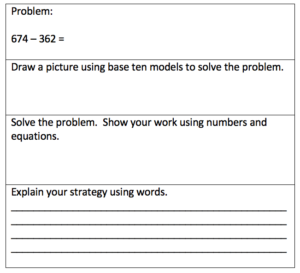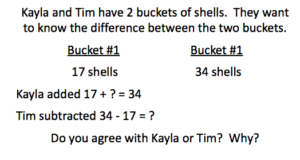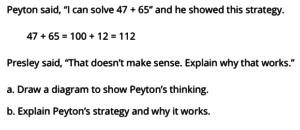Explain why addition and subtraction strategies work, using place value and the properties of operations.
Cognitive Complexity Level: 1-Recall
[divider] [/divider] Students are able to…
- Solve addition and subtraction problems using models, pictures, equations, and words.
- Ask if answers are reasonable and make sense.
- Compare their strategies to others used by students in the class.
- Clearly explain to teachers and peers the strategies they used.
[divider] [/divider] Students are able to…because teachers:
- Select appropriate addition and subtraction problems for student to solve.
- Provide ample wait time for students to solve problems using models, pictures, equations, and words.
- Ask students to compare and clearly explain their strategies to their peers using precise math language.
- Purposefully select examples and non-examples of student strategies to discuss whole group.
[divider] [/divider] Questions to ask students:
- How do your base ten blocks represent what’s happening in the addition/subtraction problem?
- Sample answer that indicates understanding: “I have 4 tens rods and 7 ones cubes to represent the number 47. Then I add 3 more tens rods and 2 ones cubes to show 32 being added to 47. Now I have 7 tens rods and 9 ones cubes, so 47 plus 32 equals 79.”
- How could you use addition to help you solve a subtraction problem?
- Sample answer that indicates understanding: “I can use the think-addition strategy! I can start with the lesser number than add up to the greater number. That will give me the difference, or answer to the subtraction problem.”
- How can you break apart the numbers by place value to help you add/subtract?
- Sample answer that indicates understanding: “I know that I can break apart the numbers into hundreds, tens, and ones, and then I can just add the hundreds together, add the tens together, and add the ones together to find the sum.”
[divider] [/divider] Additional Resources:
Additional in depth content knowledge
Blog Post: Progression of Addition and Subtraction
Blog Post: Adding From Left to Right? What’s Up with That?
[divider] [/divider] Sample Formative Assessment Tasks:
[divider] [/divider] Resources/Tasks to Support Your Child at Home:
- Before your child solves a subtraction problem, ask them to pause and think if they will have to use regrouping (or trading). Ask them to explain why or why not? Then have them use a model to solve and explain their strategy.
- Create addition and subtraction equations for your child to solve using virtual base ten blocks or an open number line. Ask them to use math vocabulary to explain each step.
- Task: Solve 164-39. Explain how you could use an open number line to find the difference. Ask your child to explain how they could use addition to solve and check their work.


